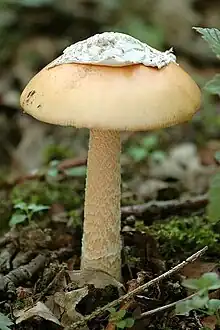Amanita viscidolutea
Amanita viscidolutea is a species of agaric fungus in the family Amanitaceae native to Brazil, first described by Menolli, Capelari & Baseia in 2009. It is listed as a vulnerable species on IUCN Red List.[1]
| Amanita viscidolutea | |
|---|---|
| Scientific classification | |
| Domain: | Eukaryota |
| Kingdom: | Fungi |
| Division: | Basidiomycota |
| Class: | Agaricomycetes |
| Order: | Agaricales |
| Family: | Amanitaceae |
| Genus: | Amanita |
| Species: | A. viscidolutea |
| Binomial name | |
| Amanita viscidolutea Menolli, Capelari & Baseia, 2009 | |
Description
Amanita viscidolutea has a yellow pileus of 40–60 mm diam, plane to depressed, with distinct striate white margin and yellowish-white patches of universal veil at center. Lamellae are free, yellowish-white, truncate to rounded-truncate. Stipe (80–120 38–9 mm), is yellowish-white and exannulate, with bulb-shaped remnants of universal veil encircling stipe base. It has a pleasant aroma. Basidiospores are inamyloid[2]
This species is solitary to subgregarious, and grows in sandy soil. It is associated and thus possibly in mycorrhizal symbiosis with Coccoloba and Guapira species, and is threatened by deforestation.[1][2]
External links
References
- "IUCN Red List of Threatened Species".
- Menolli, Nelson; Capelari, Marina; Baseia, Iuri Goulart (May 2009). "Amanita viscidolutea , a new species from Brazil with a key to Central and South American species of Amanita section Amanita". Mycologia. 101 (3): 395–400. doi:10.3852/07-079. ISSN 0027-5514. PMID 19537212. S2CID 7594094.

